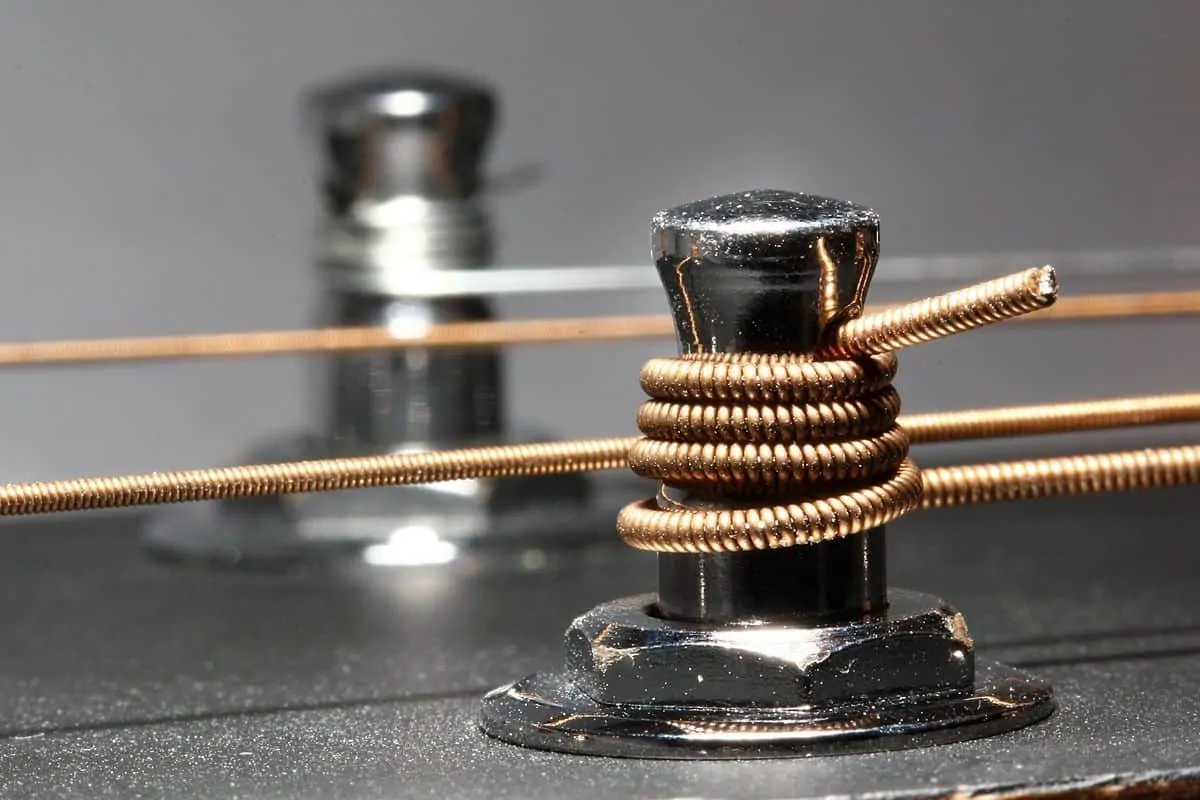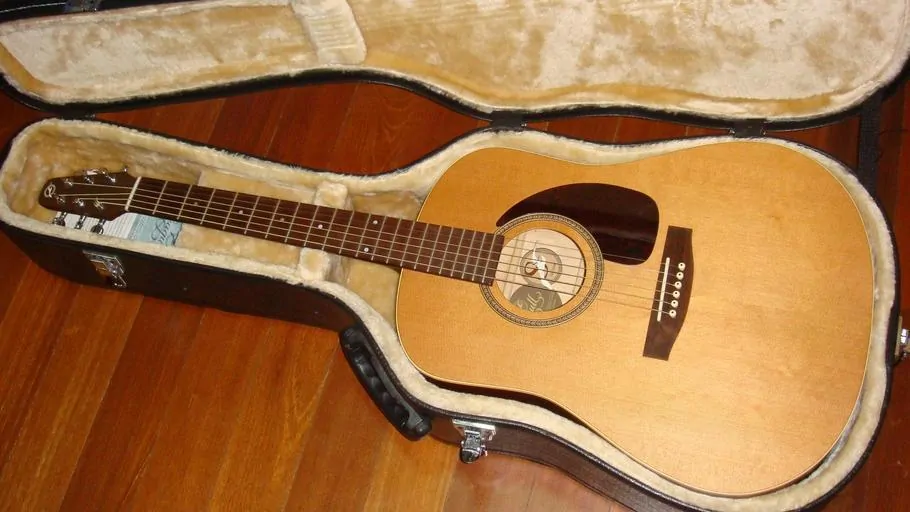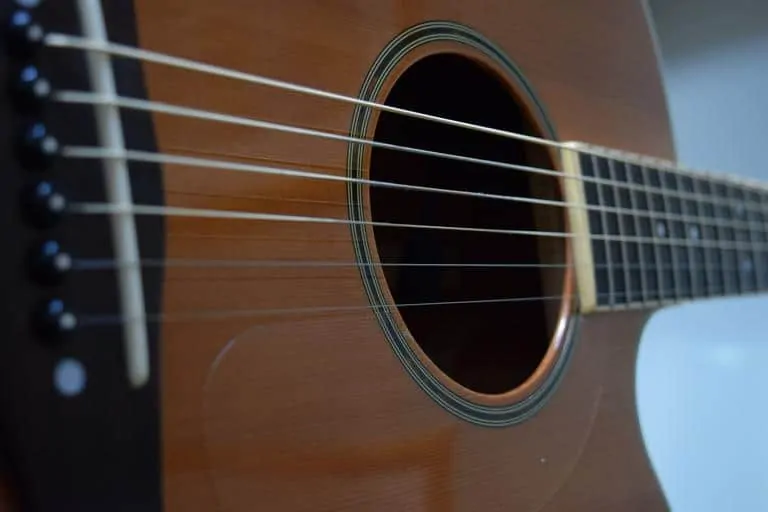Most guitar players start with a classical guitar. These instruments are easier to master, more affordable, and comfortable to carry around.
That said, let’s not forget a crucial element of classical guitars, which is the strings. You must change the strings twice a year if you regularly play; or once a year if you’re a more casual player.
Your strings get rusty because of all of the dust and sweat they catch from your fingers. The moment they begin to get rusty, they also lose quality, volume, and overall clarity.
If you’re an acoustic guitar player, either a beginner or an amateur, choosing the right set might be overwhelming. Classical guitar strings set may be cheap, but there are so many options and numbers to see that choosing one is quite complicated.
Guitar strings can slightly upgrade the tone quality and feel of your guitar.
We’ve already listed the best strings for metal before. These are strings for electric guitars, but the guide includes a buyer’s guide with everything you need to know about the matter.
You can also read our guide on the different types of acoustic guitars.
Contents
What can you achieve by changing the strings?
The right set of strings can take you closer to the overall tone you desire. More importantly, guitar strings are there to serve your playstyle.
Classical, nylon-stringed guitars depend more on the strings for their tone than electric instruments. A bad set of strings can ruin the instrument just as much as the right set can squeeze the best possible sounds.
So, after you find the acoustic guitar you want, your follow-up task is finding the best-suited strings.
Our guide takes you there. But, first, we have to cover the basics.
The material of classical strings is nylon. More “modern” acoustic guitars use steel or bronze instead.
What are acoustic guitar strings?
Most people recognize classical guitar strings merely as nylon strings. Up until WWII, these were made out of silk and intestine.
The design remains similar, though. Back then, the thickest strings came wrapped in silk, whereas the thinnest ones were plain.
Today’s strings have nylon material as it’s cheaper and easier to produce. The string that comes on classical strings imitates the traditional sound of gut. Keep in mind that gut (cow gut, pig gut, etc….) was the only material available at the moment.
Apart from being cheaper, easier to produce, and less gruesome, nylon has an extra advantage. The material feels softer on the fingers. In fact, it’s the softest string material currently available.
The vintage material for classical guitar strings was animal gut.
Choosing the right classical guitar strings
Classical strings come in different gauges, which we’re about to list. However, the essential factor is tension, which determines the overall feel of the units.
Nylon strings come in high, normal, and low tension. High-tension models are hard to fret and have plenty of volume. Low-tension models are the easiest to fret as they have less volume. And normal-tension strings are a balance between the other two models.
You must be aware of your guitar’s sound before going for a guitar string model. Some acoustic guitars are powerful on the treble so that a high-tension set might tame the instrument’s brightness.
At the same time, high-tension strings might give you extra control at the lows.
However, my advice is to experiment with different strings to find the right one. You can play around with your friend’s instruments or try various guitars at the local music shop. Otherwise, you can always change the strings again after six months.
This was just a rundown, down. Overall, choosing the right set of guitar strings depends on three things:
- Material
- Gauge
- Tension
Bear in mind that some strings are aimed for flamenco or Spanish guitars only. These instruments feature strong and bright percussive tones, and so flamenco strings emphasize the same element.
At the same time, “flamenco” strings pair well with darker-sounding instruments.
My advice for you is to check the strings of your current guitar. You could check the model online to check the strings and see what else it could use.
Classical string material (treble strings)
The material for the treble strings (high-E, B, G) is different from the lower strings (low-E, A, D).
Most treble string material comes in materials that imitate silk and gut. These are the modern options:
Clear nylon: it’s the most common material for the 1st, 2nd, and 3rd string. It offers a balance between warmth, clarity, and brightness. They also have a fair projection, sustain, and vibrato.
Nylon is not as powerful as other materials in terms of output, but it’s definitely the smoothest. It’sBlack nylon: it produces a more mellow, warmer tone. It also has an emphasis on treble overtones, which makes it a popular choice for folk genres.
Black Nylon: This produces a warmer, more mellow tone with more treble overtones than clear nylon. It is a popular choice for folk.
Titanium: Titanium produces a brighter, crisper sound. Strings made with titanium are often used to brighten up a darker sounding guitar. These also boost good sustain and vibrato.
Carbon fiber: carbon strings are loud and incredibly durable. However, they have a short sustain and offer a thin sound.
Still, if your guitar is dark, carbon fiber can be a perfect choice.
Composite: it produces the brightest sound and with the strongest projection. Composite is a common material for G string only as it offers a smooth transition between bass and treble strings.
Composite strings are the natural companion of fingerstyle guitar playing.

Classical string material (bass strings)
The ass strings commonly feature multi-filament composite core or multi-filament nylon construction. Additionally, the core is wrapped in various materials.
These materials may be:
Bronze: bronze windings may have 20% zinc plus 80% copper, which is why you might see it as 80/20 bronze, gold, or brass.
The sound of these bass strings has good sustain and brightness.
Silver: as a winding material made of silver and coating, it produces a warm tone.
Strings may come uncoated or coated. Coated strings are more durable but a bit more pricey.
Classical string gauge
Nylon strings come with different gauges, which refers to the thickness of the units.
The gauge goes in a non-linear fashion. That means the diameter of the high E is progressively thinner than the lower E string.
The thinner the strings, the fastest they are to play. At the same time, thicker strings offer a beefier tone and withhold heavier playstyles. For example, you can down-tune a guitar with heavy-gauge strings.
Light gauge strings:
- Are easy to play
- Allow easy bends
- Break easily
- Produce less sustain and volume
- Cause fret buzzing
- Have less tension, which is the safe choice for old and vintage guitars
Heavy gauge strings
- Are harder to play
- Require extra finger and hand strength to play chords and bends
- Produce more sustain and volume
- Create more tension on the guitar’s neck
Acoustic guitar string brands identify gauges with words like “heavy” or “light.” The precise meters vary among different manufacturers.
Typically, here’s what we’d find (the number refers to the diameter of the string in millimeters):
| Extra light | Light | Medium | Heavy | |
| E | 0.10 | 0.12 | 0.13 | .0.14 |
| B | 0.14 | 0.16 | 0.17 | 0.18 |
| G | 0.23 | 0.25 | 0.26 | 0.27 |
| D | 0.30 | 0.32 | 0.35 | 0.39 |
| A | 0.39 | 0.42 | 0.45 | 0.49 |
| E | 0.47 | 0.54 | 0.56 | 0.59 |
Notice that the diameter differences are minimal. You might not even notice the difference between a light set and a heavy set.
That set, you might as well go for heavy gauge nylon strings, as they produce the best results -you may not even see the difference between the various gauges.
Either way, you can always go for a normal gauge, an option for all genres and playstyles.
Ball-end vs. plain-end strings
Acoustic strings are hard to change for beginners. If they don’t come with handy ball-ends, you’ll have to learn how to tie them to the bridge, which takes practice.
Rather than learning how to tie them, beginner -and zero-hassle- musicians prefer strings with a ball-end. These models work like a set of steel strings: you insert them through the bridge, tune it up, and play.
Keep in mind that some guitar players claim ball-end strings have less volume than plain-end strings. I think the difference is minimal, though.
Still, ball-end strings are better for electro-acoustic guitars simply because the angle takes them closer to the piezoelectric pickup. That results in a better sound.
Here’s a tutorial video on how to change acoustic guitar strings:
<iframe width=”948″ height=”533″ src=”https://www.youtube.com/embed/0xxeRFEP1Y4″ frameborder=”0″ allow=”accelerometer; autoplay; clipboard-write; encrypted-media; gyroscope; picture-in-picture” allowfullscreen></iframe>
Classical string tension
Nylon strings also come in different tensions.
Commonly, you’d find low (“light), normal (“medium”) and high tension (“strong” or “hard).
Each tension presents a set of qualities that may or may not combine with your guitar and your playstyle.
Low tension
- They have the lowest output of all tensions
- They are the easiest to play
- Because of the low tension, they increase the life of your instrument. That said, light tension strings are ideal or antique/older/vintage classical guitars
- The sound emphasizes note tones instead of harmonies
- They are prone to fret buzzing.
High Tension
- These are more difficult to play
- They produce the highest output
- They put less emphasis on the notes and more focus on the note attack
- Because the tension is high, they put extra strain on your guitar. Be careful not to use them with old instruments.
- High tension strings are popular for strumming for better sound and consistent playability
Medium tension
- These represent a balance between the other two alternatives. Either way, medium sets are always a good option for every play style and genre.
Choosing the right set of classical strings comes down to personal taste and availability of the product.
As I said, the best way to find out is by trying out different products. Once you know what’s your preference, then choosing the right model becomes easier.

Top 10 classical strings for acoustic guitar
It’s time to choose. We’ve read hundreds of reviews, saw many videos, and curated with our personal experience.
If we’re wrong on our selection, please, let us know in the comments below.
D’Addario EJ45 Pro-Arte – Best overall
D’Addario is the top-rated guitar string creator. They have been around since the ’30s.
The EJ34 Pro-Arte is their best-selling classical string set. It’s also the best-seller model in the market. We’re talking about an affordable set made with silver-plated copper winding on top of their branded “multi-filament” nylon.
Also, the treble strings are made of titanium, which increases the projection and the treble.
Overall, they offer a comfortable playing experience, durability, plus a round sound.
<iframe width=”948″ height=”533″ src=”https://www.youtube.com/embed/2YkwVSENSdA” frameborder=”0″ allow=”accelerometer; autoplay; clipboard-write; encrypted-media; gyroscope; picture-in-picture” allowfullscreen></iframe>
D’Addario EXP45 – Professional choice
The D’Addario EXP45 is similar to the EJ4 set. The difference relies on the sustain this set achieves, as it’s higher than any other on the list.
The magic comes from a special micro-fine coating the brand applies to each string.
It’s the company’s most popular string for acoustic guitar. It’s also a professional choice for its warmth, consistency, and projection.
These strings come with normal tension, clear nylon on all strings, and a non-ball end (that means you have to tie them to the bridge).
The item also comes with a corrosion-resistant packaging process, so they stay fresh as they ship. That also means they will sound “new” for longer than other strings, which often refers to bright and strong. At the same time, they might sound too “snappy” for some.
I have to note this set is part of the Pro-Arte string series. The lineup is all about accuracy and superb definition on the treble strings.
<iframe width=”948″ height=”533″ src=”https://www.youtube.com/embed/WcKhb1U8JLI” frameborder=”0″ allow=”accelerometer; autoplay; clipboard-write; encrypted-media; gyroscope; picture-in-picture” allowfullscreen></iframe>
D’Addario EJ43 – Best light
Here’s another member of the Pro-Arte series. This time, though, we choose the EJ43 strings, a light-gauge, light-tension string.
Much like the other members of the series, the EJ43 has “laser selected trebles.” That means the brand measures the diameter of each treble string to deliver precise results.
As for materials, we’re looking at a proprietary multi-filament nylon core on top of the silver-plated copper for the bass strings. The treble material is nylon with the same multi-filament core.
Because of their thinner construction, they offer softer touch, more effortless playability, and mellow tonalities.
The material is nylon for bass and treble items. It follows D’Addario’s high manufacturing standards-
Overall the tone of the EJ43 is balanced, warm, and full. Also, these strings deliver a more consistent intonation.
Lastly, it ships with the same corrosion-resistant package.
I recommend the EJ43 for old or delicate guitars. Its light-tension feature won’t compromise the stability of your vintage instrument.
There’s a downside, which is the intonation. Light strings as this set tend to wander-off tune quickly.
<iframe width=”948″ height=”533″ src=”https://www.youtube.com/embed/iHzBOiPxJ9Y” frameborder=”0″ allow=”accelerometer; autoplay; clipboard-write; encrypted-media; gyroscope; picture-in-picture” allowfullscreen></iframe>
Savarez 540R Alliance – Premium choice
With over 250 years in the industry, the French musical company covers many professional artists under their umbrella. Some of their names include Igor Miagtchenkov, Alvaro Pierri, Heike Matthiesen, and Eva Fampas.
Currently, their best-selling model is the 540R, which is also their highest-quality classical string set.
It features silver-plated wound low strings, plus carbon trebles, normal tension, and light gauge.
The model is more expensive than standard alternatives, but the price difference is minimal. What you get in return for a couple of extra bucks is increased output, brightness, and clarity.
Another thing to note is the tension. These strings are quite stiff, which minimizes fret buzzes and “error” sounds. That makes them ideal for beginners and superb for experienced players.
Overall, the material choice of the 540R is all about quality. You won’t get any better than this.
<iframe width=”948″ height=”533″ src=”https://www.youtube.com/embed/7_WJOTx8gfM” frameborder=”0″ allow=”accelerometer; autoplay; clipboard-write; encrypted-media; gyroscope; picture-in-picture” allowfullscreen></iframe>
Savarez 520R – Most versatile
The Savarez 520R is a straightforward set. It’s reliable, budget, and readily available. It also carries the brand’s reputation of top-tier nylon strings for classical acoustic guitars.
This is a normal-tension set with silver-plated wound bass and rectified nylon treble strings. Though the treble strings have high tension, so the set plays with two different tension levels.
In terms of playability and tonality, the 520R is the go-to set for everything. The all-around solution caters to every style, guitar, and player.
Notably, the set delivers a gritty, “unpolished” tone by lessening the high overtones. Also, the strings have a particular texture that makes controlling vibratos, bends, and arpeggios quickly.
These features add up for a clear and transparent pitch, which is why it is generally good for everything.
Subjectively, you might not like the warmth of its bass strings, though.
<iframe width=”948″ height=”533″ src=”https://www.youtube.com/embed/7_WJOTx8gfM” frameborder=”0″ allow=”accelerometer; autoplay; clipboard-write; encrypted-media; gyroscope; picture-in-picture” allowfullscreen></iframe>
Savarez 500CJ New Cristal Corium – Best playability
The 500CJ is another popular set. Is part of the Cristal Corium series. The lineup delivers trebles made of cristal clear nylon, plus silver-plated wound corium basses.
These materials deliver a clear and focused sound. Also, they bring a complete dynamic range response.
“CORUM” is a proprietary rectified material that mixes nylon and silver. It’s a technological advance Savarez has been improving for decades.
In particular, the set brings “Corum” silver-wound bass strings plus “Cristal” nylon trebles.
This is also a medium set with thick gauges on the “thinner” strings (0.29-0.33-0.41). It also comes with high-tension.
Now, despite its high-tension, the playability is superb due to the proprietary materials. Also, the sound is very balanced from the 1st to the 6th string.
The downside is the high-tension itself. Installing these on your guitar might be challenging, so consider talking to a luthier first.
Overall, though, we’re looking at a great set that mixes resistance with tonal balance.
<iframe width=”948″ height=”533″ src=”https://www.youtube.com/embed/scC3JfnF_C8″ frameborder=”0″ allow=”accelerometer; autoplay; clipboard-write; encrypted-media; gyroscope; picture-in-picture” allowfullscreen></iframe>
Hannabach 815 Silver Special – Best for recording
Hannabach dates back to Bohemia, Germany, in 1869. The German brand has produced thousands of guitar strings since then. Their name means advanced solutions that suit classical playstyles.
The 915 Silver Special is their best classical string series. It’s a multi-purpose set that sells with different tensions and gauges.
It features nylon trebles with a proprietary “precision-round” for a more stable sound. Then, the bass strings carry a silver-special material for, again, a more consistent sound.
The result is excellent for recording acoustic guitars as it focuses and balances the sound of the instrument. Overall, it can take your sound closer to a professional level, even if you’re playing on a budget guitar.
Also, the package looks amazing. It’s a keeper.
<iframe width=”948″ height=”533″ src=”https://www.youtube.com/embed/0Z17njmMGQ4″ frameborder=”0″ allow=”accelerometer; autoplay; clipboard-write; encrypted-media; gyroscope; picture-in-picture” allowfullscreen></iframe>
La Bella 820 Red – Best for Flamenco
La Bella has one of the top reputations in the instrument string market. Their products for bass guitar, electric guitar, and acoustic guitar rank equally higher.
The set has red nylon treble strings plus silver-plated bass strings.
It also comes with LaBella’s proprietary MAP Technology (Modified Atmosphere Packaging). It prevents string tarnishing and ensures the items stay fresh over time. As a result, you get extra sound projection, transparency, and durability.
Simultaneously, the company uses a computer-controlled manufacturing process to ensure the maximum quality of the strings.
Also, I should note these are medium-tension strings. There’s another particularity about the set: the bass and treble strings have equal gauges: 0.29-0.34-0.41. Without thin strings on the treble side, the set is a bit harder to play. Still, it results in better performance, particularly for arpeggio guitar.
Overall, the tone of the La Bella Elite 820 strings is perfect for classical Flamenco or Spanish guitars. The set can also brighten a dark instrument, provide an extra attack, or add more clarity to warm instruments.
Also, the set is very durable.
<iframe width=”948″ height=”533″ src=”https://www.youtube.com/embed/UhtwvhLrsxA” frameborder=”0″ allow=”accelerometer; autoplay; clipboard-write; encrypted-media; gyroscope; picture-in-picture” allowfullscreen></iframe>
Ernie Ball 2069 Earthwound – Best for beginners
Here’s another Earthwound set, this time by another reputed string manufacturer.
Earnie Ball is the go-to choice when it comes to electric guitar strings. However, they haven’t exported their reputation to the acoustic guitar market.
Still, the Earthwound set is simple, affordable, reliable, and good.
The treble material is nylon, whereas the bass strings are made of 80/20 bronze.
It’s the perfect set for folk guitar, beginners, hobby players, and quick repairs. It helps that it comes with easy ball-ends.
Overall, the set feels light, but it delivers stable intonation and consistent tone. That said, the Earthwound is the beginner-friendly ball-end nylon string that might suit your needs. Its convenience, tone, and price were more than enough to give them a spot on our list.
<iframe width=”948″ height=”533″ src=”https://www.youtube.com/embed/2VJOpT7gjU0″ frameborder=”0″ allow=”accelerometer; autoplay; clipboard-write; encrypted-media; gyroscope; picture-in-picture” allowfullscreen></iframe>
Martin M160 -Best budget
Martin & Company has been around since 1833. Their deal is making high-tier acoustic guitars, and they have made significant advances in the market since the beginning. For example, they were the first to introduce dreadnought bodies, and they were also the first to create x-bracing on the soundholes.
Many customers don’t know Martin produces guitar string as well -just as much as mandolins, electric guitars and basses, acoustic archtops, ukuleles, and more. The M160 is a super-budget model with zero bells and whistles.
The set carries nylon trebles plus 80/20 bronze bass for a traditional sound.
Its sound is clear, articulate, and bright. That said, some people might not like the lack of warmth the set achieves.
As a beginner-friendly solution, it also brings silver-plated ball ends.
Silver-plated material is corrosion-resistant. That means it won’t wear to your finger’s oil and dirt as quickly as plastic ball ends.
However, the bronze material is not very durable, not as much as strings with silver-plated coating.
For its price tag, the Martin M160 offers a pleasing tone with high fidelity, even if they are not as durable as pricier alternatives.
<iframe width=”948″ height=”533″ src=”https://www.youtube.com/embed/xocXsDapHm8″ frameborder=”0″ allow=”accelerometer; autoplay; clipboard-write; encrypted-media; gyroscope; picture-in-picture” allowfullscreen></iframe>
In Summary
I hope my guide on the best classical strings guided you to the best alternative.
I advise you to check the videos above before you make a decision. Also, the more you know, the better you buy.
Overall, you wouldn’t go wrong with any of these items. Just make sure you’re not using a high-tension string on an old guitar. If you’re in doubt, please confirm with a luthier before making a purchase.





